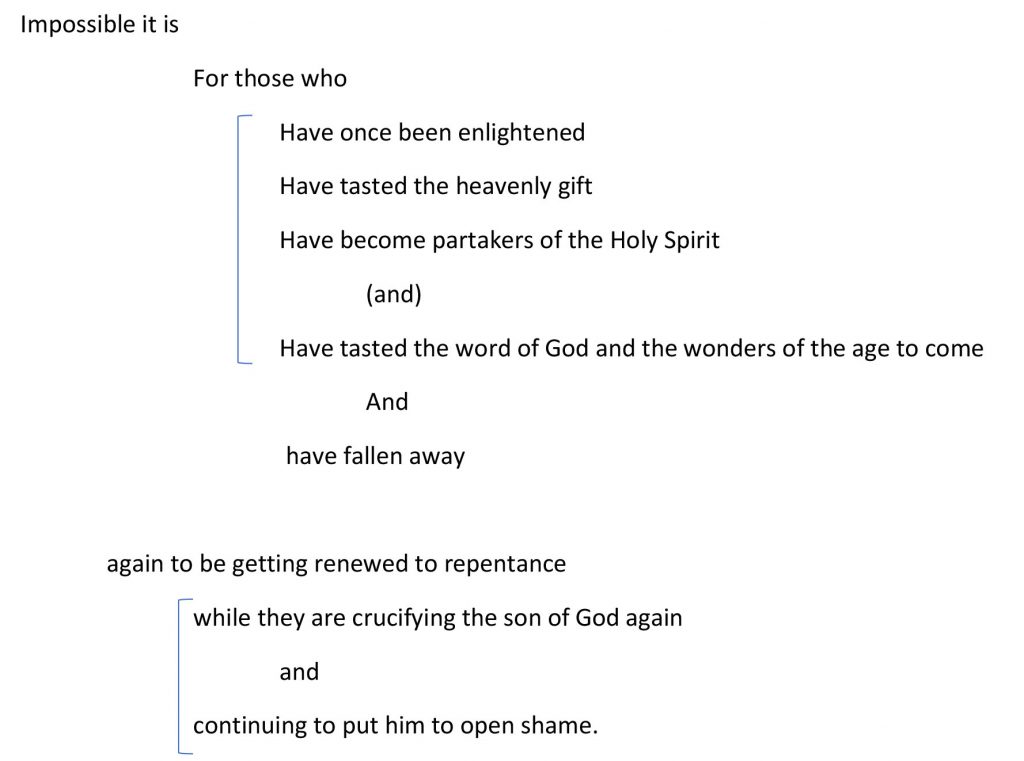Repentance in Hebrews 6:4-6
When I talked about structure, I mentioned that I’d write a follow-up after my Wednesday night class. Here’s the rundown, though I plan to keep it brief. I’m indebted to David Alan Black for the basic note about the participles in this passage, and in a scholarly article I would need to cite a number of additional sources. The structure of the passage followed my own take on it in the context of Hebrews and made the argument easier. I include this discussion in my book To the Hebrews: A Participatory Study Guide, which is currently under revision for a second edition. (The main problem with the current edition is that I created it with readings, exercises, and questions, along with several appendices with discussion. I’m putting some discussion in the lessons!)
There are a number of passages I referenced in class, but there are three passages before 6:4-6 that I see as key, and then one after. The reason is that the author of Hebrews signals new topics well ahead of the main discussion and then ties them in to later discussion.
So if you look at Hebrews 2:1, “drifting off course.” This is an early signal of what I think is the key theme of the book, one that is further developed in 6:4-6 especially. At this point, the author has presented Jesus as the true representation of God and is now ready to open up the door to the result. God has spoken in these last days through a Son, which sounds good, even exciting, but what does it mean?
Frequently Hebrews is read as a book with a message of works and perfectionism. In fact, as someone with a Wesleyan background, I’m used to starting there in my thinking. But the more I study the book, the less I think that is the correct reading. The warnings in Hebrews are not about human performance of good actions, but rather of total confidence in the one who has been presented here in chapter 1. Verses 1-4 present the Who, while the rest emphasizes that Jesus is greater than the angels. There will be more emphasis on precisely who Jesus is, but we have this pause in the first few verses of chapter 2 so we can get a preview of the theme.
Through the rest of chapter two and into chapter five, but especially in 4:12-16, we’ll develop the things that make Jesus ideal as our priest, even though we aren’t quite sure what such a priest will accomplish.
In 5:8-9 we get the second key connection, as we are told that Jesus learned obedience through suffering (and a rich passage that is, even though I’m just going to touch on it only briefly. Verse 9 tells us that he was perfected. It is this “perfection” that I think is the key object of Hebrews, the perfection of Jesus, not the perfection of any human being.
I see 5:11-14 as a bit of reverse psychology, challenging the readers/hearers with their dependence on milk just before he goes ahead and introduces some meat anyhow.
The third key passage is Hebrews 6:1, and “going on toward perfection.” It’s my understanding that United Methodist pastors are still asked this question on ordination, and I believe not a few have their fingers crossed when they answer. Figuratively speaking, of course! But though few translations do it, this can be taken as a passive, and thus be translated “carried on toward perfection” rather than “going on toward perfection.” I would go further and argue that the perfection that we are to go on toward is Jesus, and is only to be attained “in Christ” and not by us or as something possessed by us.
Having jumped from signpost to signpost, this leads to 6:4-6. I have noted previously that I don’t take this as a “once out always out” passage, but rather as a warning against rejecting the voice or urging of the Holy Spirit. Paying closer attention to structure and the participle tenses helped back that view up and expand it.
Here’s my translation with structure:
I have summarized the theme of Hebrews as “get on the right train and stay on it until you reach the destination.” The key is that if you have the best, the greatest, or even the only hope of rescue and you don’t take it, rescue escapes you. That’s why I have the temporal sense here. If you are rejecting the final sacrifice of Christ, according to the concepts developed in the preceding five chapters, what option is there? Jesus, the Christ is sacrificed once-for-all, and cannot be sacrificed again. If we continue to fail to accept the finality, we are crucifying him afresh.
But it’s even more simple than that. You can’t accept while you reject.
Does that make it too simple? Actually, I think it makes it a clear statement of precisely the point of Hebrews. You have two choices: This train or no train.
And that leads to the final passage I want to use, Hebrews 10:26-27. Here we have no sacrifice for sin after Jesus. It’s often used in sermons to threaten people with how seriously they should take New Testament commands. But that’s not the point at all. There is no more sacrifice because the sacrifice has been offered. If you don’t accept the sacrifice, there isn’t another one. You can’t redo it or substitute it.
The whole message centers on confidence in the grace that has opened this “new and living way” (10:20), in the perfection of our High Priest, and in the necessity of placing our full confidence in Him.
Let me add that I believe that the “cloud of witnesses” in Hebrews 12:1ff should be seen as those who are cheering us on because they have experienced the weaknesses and the failings that we have and know the grace of God and the final reward. It should not be used as a club as I have heard it preached, in the sense of: “Look at all these holy people who are watching you. Don’t screw up!”
(Featured Image Credit: Openclipart.org.)




Henry, I love your “big picture statement” and specific/illustrated progression of the message of the Book of Hebrews. It points out what I’ve read and heard at times through my decades as a pastor’s kid, pastor’s wife, member of perhaps 100 congregations, and educator’s wife – interacting with thousands of people in my lifetime. I’ve also heard from earliest years (from my father and most recently our current pastor, as well as reading and personal study) a message that correlates with your post. Thanks for this.
Henry,
Yes, exactly! The reason, as I have observed, for any other understanding than articulated here is the penchant to view passages apart from the entirety of the message of the letter/book they are in.
Even those who advocate context, myself included in the past, often mean the paragraph or chapter before and possibly the one after. I now advocate reading the letter/book in its entirety first, finding the major theme(s) and interpreting passages in this context and then even wider.
As a Pastor-Teacher, this is why I find verse by verse exposition so effective in helping believers to understand doctrine and conform to the image of Christ.
Tim
I’ve been traveling and missed approving this immediately. I agree, of course! There are so many places where getting the theme of the entire book is crucial in understanding a specific passage.